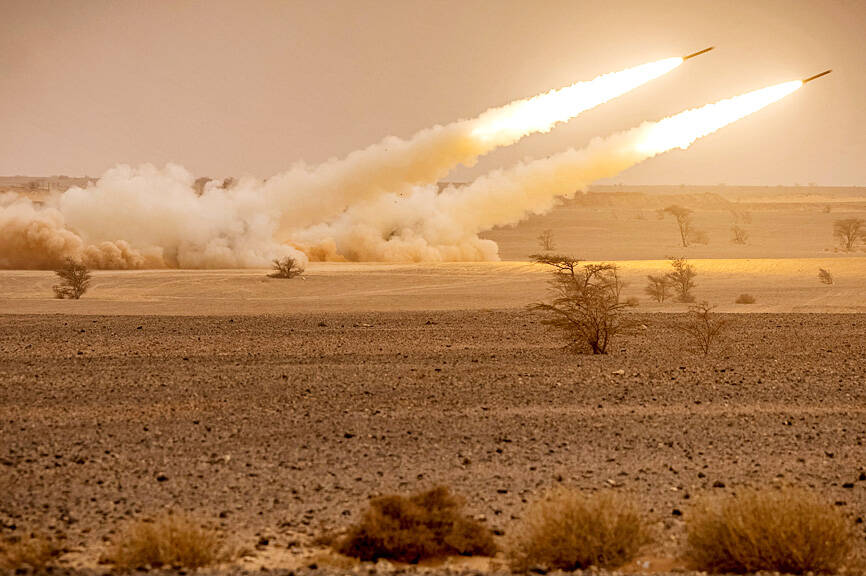The military has allocated funds to buy more M142 High Mobility Artillery Rocket System (HIMARS) launchers from the US after canceling its original plan to purchase M109A6 “Paladin” self-propelled howitzers, a proposed defense budget showed yesterday.
The proposal, which was sent to the legislature for review, indicates that the army is planning to buy 29 HIMARS, a truck-mounted, multiple-launch system, 18 more than originally planned.
It is also aiming to buy 84 ATACMS, a long-range guided missile system, up from 64 that it originally wanted, as well as 864 precision rockets that can be used by HIMARS, which has a strike distance of 300km, the proposal showed.

Photo: AFP
The total budget is set at NT$32.5 billion (US$1.07 billion), with the first batch of 11 HIMARS expected to be delivered in 2024 if the order is made, the proposal showed.
The plan is to provide high-precision, high-mobility, long-distance firepower to Taiwan’s frontline islands to eliminate invading enemy forces, as it would be difficult to quickly reinforce such locations, the army said.
The decision to buy more HIMARS was made after the army decided not to buy 40 Paladins, with the Ministry of National Defense in May saying that the US informed it that the self-propelled howitzers would not be delivered on time due to inadequate production capacity.
Instead, Washington proposed other long-range, precision-strike weapon systems such as HIMARS, the ministry said in a news release at the time.
The government last week announced its general budget plan for fiscal 2023, which showed an increase in proposed spending on national defense next year of nearly 14 percent, or more than NT$70 billion, from this year.
The money would fund the development of domestically built warships and warplanes, improve equipment and weaponry for troops, boost the nation’s reserve forces and develop asymmetrical warfare tactics, President Tsai Ing-wen (蔡英文) said.
Meanwhile, Taiwan and the US have signed a NT$21.7 billion deal for four MQ-9B SeaGuardian aerial drones with ground control stations and other support systems, with the units scheduled for delivery in 2025.
The deal inked by the air force and the American Institute in Taiwan is implemented through December 2029, when installation of the support systems is to be completed, the ministry said in a contract notice yesterday.
The contract’s implementation timetable is a year longer than previously negotiated.
The price tag includes NT$16.88 billion for the drones themselves, with the remainder for control stations, technical training and operational expenses related to the procurement, it said.
The implementation of the contract would take place partially or entirely in Hualien County, it said.
A defense official said that the drones would boost the military due to their long loiter time, all-weather observation and surveillance sensors, and their ability to launch airstrikes.
The drones can directly support combat troops, or disrupt enemy operations, the official said.

The combined effect of the monsoon, the outer rim of Typhoon Fengshen and a low-pressure system is expected to bring significant rainfall this week to various parts of the nation, the Central Weather Administration (CWA) said. The heaviest rain is expected to occur today and tomorrow, with torrential rain expected in Keelung’s north coast, Yilan and the mountainous regions of Taipei and New Taipei City, the CWA said. Rivers could rise rapidly, and residents should stay away from riverbanks and avoid going to the mountains or engaging in water activities, it said. Scattered showers are expected today in central and

COOPERATION: Taiwan is aligning closely with US strategic objectives on various matters, including China’s rare earths restrictions, the Ministry of Foreign Affairs said Taiwan could deal with China’s tightened export controls on rare earth metals by turning to “urban mining,” a researcher said yesterday. Rare earth metals, which are used in semiconductors and other electronic components, could be recovered from industrial or electronic waste to reduce reliance on imports, National Cheng Kung University Department of Resources Engineering professor Lee Cheng-han (李政翰) said. Despite their name, rare earth elements are not actually rare — their abundance in the Earth’s crust is relatively high, but they are dispersed, making extraction and refining energy-intensive and environmentally damaging, he said, adding that many countries have opted to

CONCESSION: A Shin Kong official said that the firm was ‘willing to contribute’ to the nation, as the move would enable Nvidia Crop to build its headquarters in Taiwan Shin Kong Life Insurance Co (新光人壽) yesterday said it would relinquish land-use rights, or known as surface rights, for two plots in Taipei’s Beitou District (北投), paving the way for Nvidia Corp to expand its office footprint in Taiwan. The insurer said it made the decision “in the interest of the nation’s greater good” and would not seek compensation from taxpayers for potential future losses, calling the move a gesture to resolve a months-long impasse among the insurer, the Taipei City Government and the US chip giant. “The decision was made on the condition that the Taipei City Government reimburses the related

African swine fever was confirmed at a pig farm in Taichung, the Ministry of Agriculture said today, prompting a five-day nationwide ban on transporting and slaughtering pigs, and marking the loss of Taiwan’s status as the only Asian nation free of all three major swine diseases. The ministry held a news conference today confirming that the virus was detected at a farm in Wuci District (梧棲) yesterday evening. Authorities preemptively culled 195 pigs at the farm at about 3am and disinfected the entire site to prevent the disease from spreading, the ministry said. Authorities also set up a 3km-radius control zone